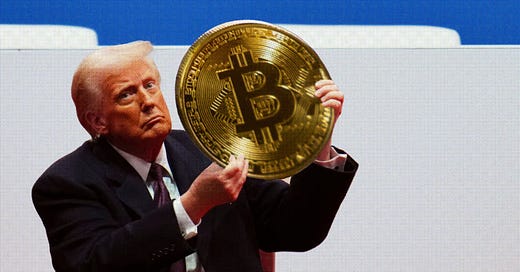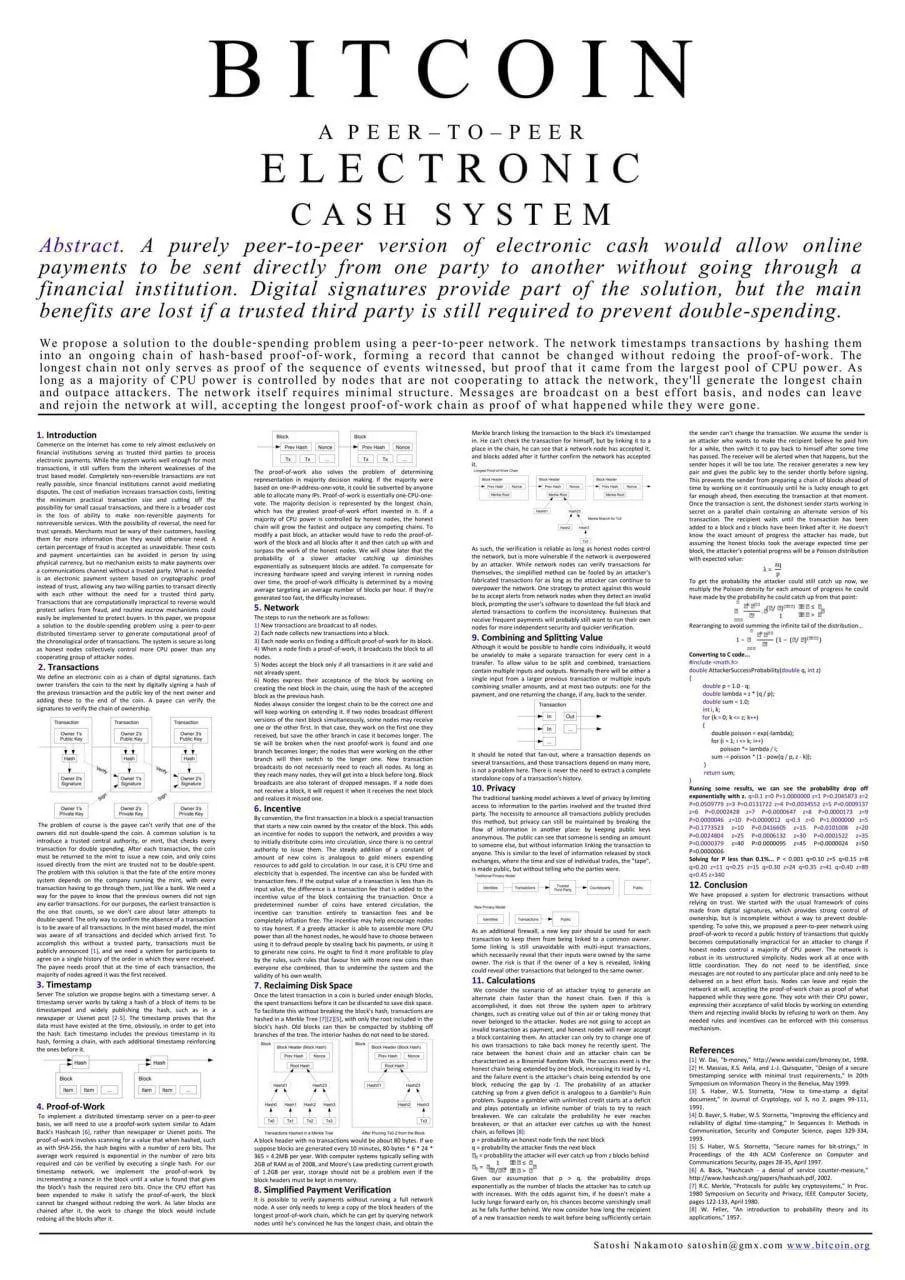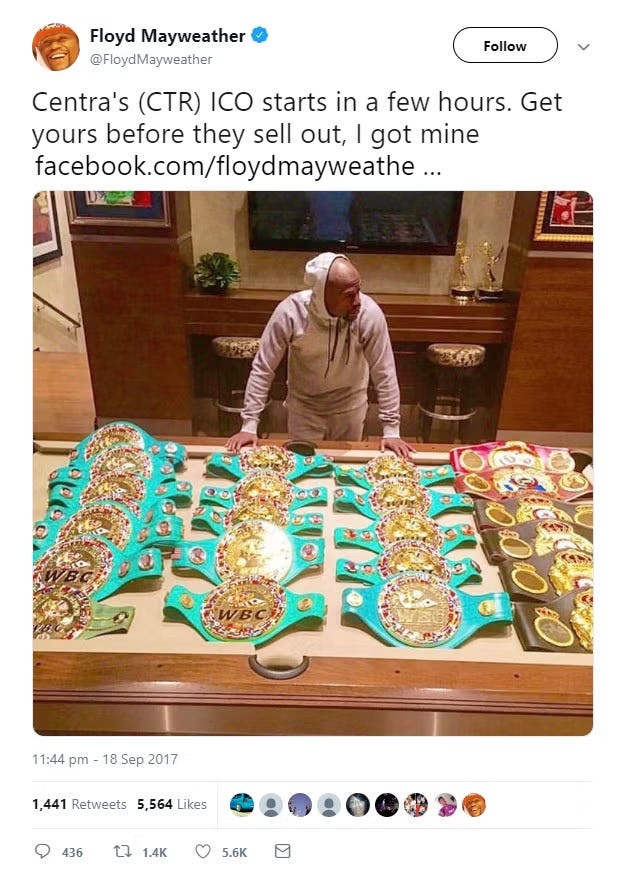Pump, Dump, Repeat
A look at the wild history of crypto and the marketing campaigns that made it what it is today.
Just days before Donald J Trump’s inauguration, the soon to be 47th leader of the free world revealed his latest project; $TRUMP, a crypto ‘memecoin’ that within days had soared to a total market cap of $12 billion.
Was this the first sign of Trump’s ‘Crypto Golden Era’?
Well, not exactly…
Within days of its launch, the $TRUMP coin collapsed, leaving hundreds of thousands of small investors in the red while Trump and his associates made off with 100s of millions in what many have described as a classic ‘pump-and-dump’ scheme.
But how did we get here?
This is the history of crypto marketing, complete with its wildest, most ridiculous moments. Buckle up.
The Early Days (2008-2012)
Bitcoin’s First Marketing Strategy? Posting in Forums.
Bitcoin wasn’t launched with a flashy ad campaign—it was quietly introduced by Satoshi Nakamoto in 2008 via an academic-style whitepaper on an obscure cryptography mailing list. Marketing budget: $0. Viral impact: Priceless.
Early Bitcoin adopters were privacy-obsessed cypherpunks who marketed it the old-fashioned way: arguing with skeptics on Bitcointalk and Reddit. The pitch? “Money, but without banks.” It sounded cool but also slightly insane.
The First Bitcoin Purchase: A $500 Million Pizza Mistake
On May 22, 2010, a Florida programmer named Laszlo Hanyecz made history by buying two Papa John’s pizzas for 10,000 BTC. At today’s prices, that’s over $1 billion for some pepperoni and cheese…yikes.
Crypto’s marketing lesson? Never ever ever ever sell, hold until your dying breath.
Silk Road: The Dark Web’s Accidental Bitcoin Campaign
Bitcoin’s first mainstream exposure came not from tech enthusiasts, but from Silk Road, the dark web marketplace where you could buy anything you wouldn’t want your mum finding out about.
Silk Road gave Bitcoin its first real-world use case, but it also branded it as the currency of criminals. It was free marketing, just not the kind that gets you listed on the Nasdaq.
The Altcoin Boom & The Birth of Meme Marketing (2013-2016)
Dogecoin: The Joke That Became a $50 Billion Market Cap
Somewhere in 2013, software engineers Billy Markus and Jackson Palmer decided that Bitcoin was too serious and launched Dogecoin, a cryptocurrency based on a meme of a confused-looking Shiba Inu.
Marketing strategy? Spam Twitter with memes. Somehow, it worked. Dogecoin became one of the biggest cryptocurrencies in the world, proving that if your coin has good vibes, people will throw money at it.
One infamous moment occurred in 2014 when the Dogecoin community raised $55,000 to sponsor a NASCAR driver whereby the car ended up with a giant Shiba Inu face on it.
Wall Street & Celebs Take Notice (2017-2018)
By 2017, crypto had evolved from an underground movement into a full-on financial gold rush. The ICO (Initial Coin Offering) craze saw startups raising billions in minutes, often with no product, no business model, and sometimes, not even a real team.
Celebrities Got Involved—And It Went Horribly Wrong
Kim Kardashian promoted EthereumMax ($EMAX) to her 250 million Instagram followers without disclosing she was paid $250,000 for it. The SEC fined her $1.26 million after the token collapsed in what was essentially a pump-and-dump scheme.
Paris Hilton promoted LydianCoin, an ICO promising a revolutionary AI-driven ad platform. The project was later exposed as fraudulent, disappearing along with investors' money.
John McAfee charged $105,000 per tweet to promote crypto projects, often without disclosing he was being paid. This eventually led to fraud and tax evasion charges, with authorities accusing him of misleading investors for personal gain.
Bitconnect: The Ponzi Scheme That Hosted a Literal Clown Show
Bitconnect was one of the biggest scams in crypto history, running a Ponzi scheme disguised as a lending platform. But what made it legendary was its marketing.
The company held a conference featuring a bizarre, cult-like speech from their promoter, Carlos Matos, who screamed:
“BIIIIITCOOOOONNEEEEEEECT!!”
The phrase went viral, becoming the greatest meme in crypto history—right before the whole thing collapsed and billions vanished (source).
Crypto Goes Mainstream (2019-2021)
By 2021, crypto had gone corporate. Exchanges like FTX, Crypto.com, and Binance were spending hundreds of millions on marketing.
The Super Bowl Ad Era
FTX ran an ad starring Larry David telling people crypto was a once-in-a-lifetime opportunity. The irony? FTX collapsed in one of the biggest fraud scandals in history.
Crypto.com’s “Fortune Favors the Brave” ad featuring Matt Damon convinced thousands of people to buy Bitcoin at $60K. By 2022, those same people were reconsidering their life choices.
El Salvador: The First Country to YOLO Into Bitcoin
In 2021, El Salvador's president, Nayib Bukele, decided that Bitcoin should be the country's official currency. The government bought Bitcoin using taxpayer money—at the market top.
However, fast forward to 2025 and the IMF is currently begging El Salvador to stop buying bitcoin and yet they simply won’t stop…
The Crash & Reputation Crisis (2022-Present)
FTX’s Collapse: The Fireball Heard Around the World
FTX, once the golden child of crypto, imploded in 2022 in spectacular fashion. Turns out, when your company is run by a polyamorous sex cult in the Bahamas secretly gambling customer deposits, things tend to go south.
Marketing lesson? Maybe don’t spend $300 million on sports sponsorships while allegedly running a Ponzi scheme.
Regulators Finally Show Up
By 2025, crypto marketing has changed. Gone are the days when flashy ads and celebrity endorsements were enough to pump a token overnight. After years of rug pulls, bankruptcies, and scandals, regulators have stepped in with stricter guidelines, forcing crypto projects to actually explain what they do before selling tokens. What a concept!
Social media platforms have also tightened their ad policies, influencers must disclose sponsorships, and AI-driven marketing gimmicks face greater scrutiny.
The Future of Crypto Marketing in 2025: Boom or Bust?
Crypto marketing in 2025 is entering a volatile new phase, shaped by AI-driven campaigns, regulatory uncertainty, and a post-halving market surge. With Donald Trump back in the White House, crypto regulation is unpredictable—some factions push for deregulation, while others warn of financial instability and fraud. The SEC remains erratic, creating an environment where companies either capitalise on looser rules or brace for sudden crackdowns.
Meanwhile, AI is transforming crypto marketing, from hyper-personalised ads to deepfake influencers promoting tokens. While this boosts engagement, it has also led to a surge in scams, with AI-generated hype fueling fraudulent projects. Social media platforms are tightening restrictions on crypto ads, forcing companies to rely on viral, community-driven marketing—a strategy that can skyrocket a token overnight or destroy it with a single bad headline.
With Bitcoin’s 2024 halving driving renewed investor interest, marketing budgets are at an all-time high. Yet the industry remains a minefield of misinformation, where AI, meme culture, and regulatory chaos collide.
Will crypto marketing mature into a sophisticated, respectable industry? Or will it collapse under the weight of scams and legal crackdowns?
Only time will tell…
Crypto Business Fails: The Most Ridiculous Flops in Digital History
You won’t be shocked to hear that not every crypto venture makes it to the moon. Some crash and burn so spectacularly that they become legends in their own right.
So, to finish off this article, i’ve found three of the funniest (and most disastrous) crypto marketing flops in recent history, enjoy!
1. Terra’s $40 Billion Implosion
Terraform Labs, led by Do Kwon, promised to revolutionise finance with TerraUSD (UST)—a stablecoin designed to maintain its $1 peg through algorithms instead of reserves. Investors poured in, lured by promises of 20% returns via the Anchor Protocol. For a while, it worked—UST became a top stablecoin, and its sister token, LUNA, skyrocketed in value.
In May 2022, UST lost its peg, triggering a death spiral that wiped out $40 billion in days. Retail investors were devastated, regulators cracked down, and Do Kwon—once infamous for mocking critics—went on the run before his arrest. Terra’s collapse became one of crypto’s biggest failures, proving that hype can’t fix a broken system.
2. Centra Tech: The Floyd Mayweather-Endorsed Crypto Scam
Boxing legend Floyd Mayweather and rapper DJ Khaled were among the high-profile influencers who promoted Centra Tech, a crypto startup promising a revolutionary debit card that could seamlessly convert cryptocurrencies into fiat for everyday purchases. With celebrity endorsements and aggressive marketing, the project raised over $25 million through an ICO, luring in eager investors who believed they were backing the future of crypto payments.
However, Centra Tech turned out to be a complete fraud—the company had no actual partnerships with Visa or Mastercard, and its founders had fabricated credentials. Before the product even launched, the SEC stepped in, exposing the scam and arresting its creators. Mayweather and Khaled were fined for failing to disclose they were paid to promote the ICO, marking one of the first major crackdowns on celebrity-backed crypto schemes.
3. Squid Game Token: The Play-to-Earn Rug Pull
Capitalising on the massive success of Netflix’s hit show Squid Game, anonymous developers launched $SQUID Token, a play-to-earn cryptocurrency that promised investors the chance to participate in a real-life Squid Game-inspired experience. The project’s slick website, viral marketing, and mainstream media coverage helped it gain traction, attracting millions in investments within days. As excitement grew, the token’s price soared from pennies to over $2,800, with early investors believing they had struck gold.
But there was one problem—nobody could sell their tokens. The project was a classic rug pull, where the developers locked sell transactions, preventing investors from cashing out. Once enough hype had driven the price to absurd heights, the creators drained the liquidity and disappeared, leaving behind a worthless token. Within minutes, $SQUID plummeted to nearly zero, proving once again that just because a crypto project is trending doesn’t mean it’s legitimate.
A Final Thought
Crypto marketing in 2025 is a high-risk, high-reward game. AI and viral hype can drive massive success—but scams, misinformation, and regulatory crackdowns remain ever-present threats. Whether the industry matures or implodes, one thing is certain: crypto never fails to entertain.

















This is why knowing your audience is important.
Crypto is essentially marketing to gambling addicts in disguise.